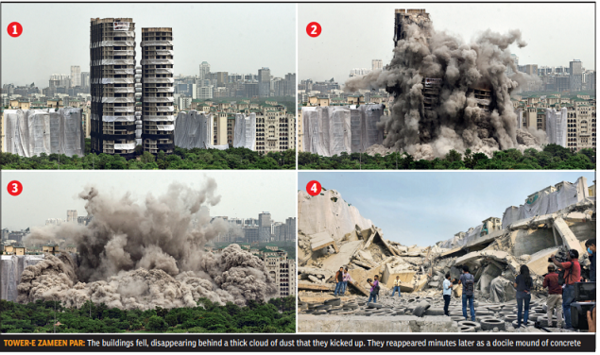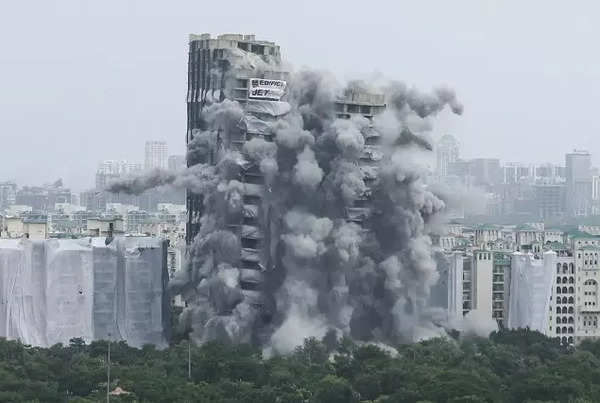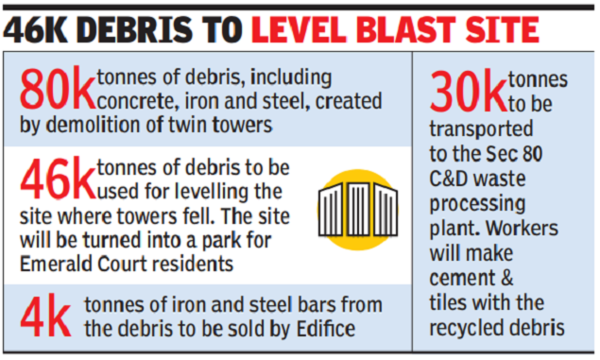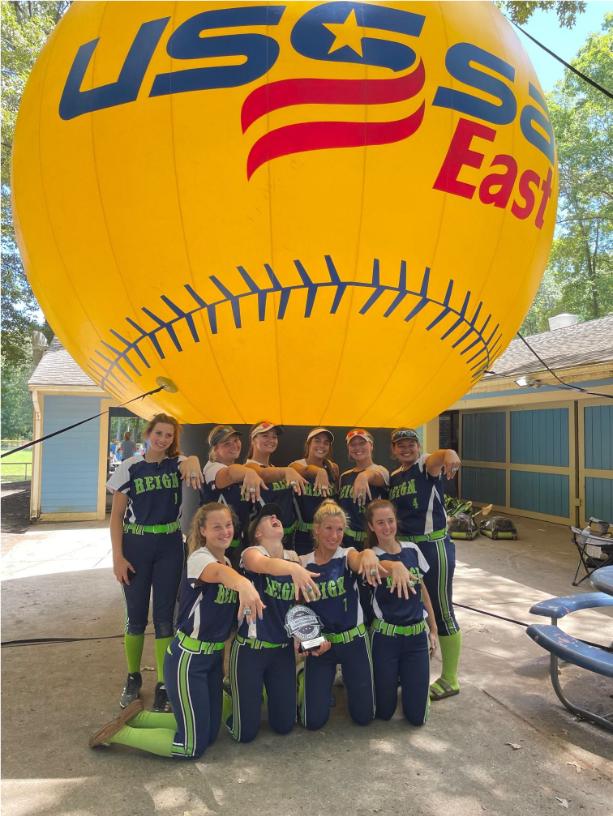
Gone in 12 seconds: Noida twin towers rest in pieces | India News
[ad_1]
The buildings succumbed to a ‘waterfall implosion’ that went to script, with the inspection team that went on a recce immediately afterwards reporting no major damage to the two sets of buildings — at ATS Greens Village and Emerald Court — flanking the twin towers in Sector 93A.
Apex (103 metres) and Ceyane (94 metres) — the tallest in India to be brought down through a controlled implosion — fell in exactly 12 seconds once the detonator triggered the series of charges connecting 3,700kg of explosives that were loaded into the two towers for the Supreme Court-ordered exercise.
The reaction of Joe Brinkmann, the architect of the explosion that brought the towers down, summed it up. “Thank you, lord,” he said, when asked what his first thought was after the demolition. “It was an intense day. Emotions were high. There was a lot of mental and physical effort. We sweated a lot and smoked cigars. There was a puja in the morning as well, praying for the safe demolition,” he added.

Shankar Ghosh, who lives in Aster-2, the residential building closest to the twin towers (9 metres away), found his apprehensions turn to relief and then pleasant surprise when he set foot inside his duplex apartment on the 11th floor on Sunday afternoon once the dust had settled and security clearance was given. “I was the first to enter Aster-2 after the demolition. Surprisingly, there was no dust inside the house. I checked all around and found no damage at all. I had installed a camera on the balcony to capture the fall of the twin towers. The footage was recorded beautifully, but the cameras detected no vibration,” Ghosh told TOI.

Specially for Aster-2, a container wall packed with debris was installed in the narrow gap with the twin towers as a shock absorber. The idea appeared to have passed with flying colours.
A portion of the boundary wall of ATS Greens Village, however, was smashed by tumbling debris. “I am seeing pictures of the boundary wall being damaged, but hopefully, the foundations have not been shaken,” said Vandana Dua, a resident. “I am happy. We knew the towers would one day come down,” she added.
Following the controlled implosion, the twin towers disappeared behind the thick cloud of dust that they kicked up as they tumbled. They reappeared a few minutes later as a docile mound of concrete rubble roughly the height of a three-storey building. The wreckage presented a picture of a neighbourhood hit by war, but the happy faces around, loud cheers from onlookers and the explosive experts flying into each other’s arms in relief and celebration quickly belied that.
The demolition had built up as a grand spectacle through the day with people lining along the Noida expressway and taking vantage positions at rooftops, balconies and parks to watch the towers fall. Live blogs on website and non-stop TV commentary that resembled a thrilling T20 match built up anticipation.
At 2.30pm, a hushed silence took over – the chatter stopped, broadcasts muted audio and all eyes were peeled on the twin towers. A few heart-stopping seconds later, with a crack and a rumble that sent pieces of concrete and jets of dust shooting into the air from the upper floors, the towers began to disintegrate.

Ceyane fell first and Apex, designed to fall towards Ceyane, followed. The implosion shook the ground and people up to a kilometre away said they had felt the vibrations. “All of us (members of the blasting team) were crying after the twin towers came down safely,” said Chetan Dutta of Hisar who pressed the button that triggered the explosion, speaking of their relief.

The six-member team of blasters from Edifice and Jet, who were stationed at the initiation point 100 metres from the twin towers, rushed back to the site once the towers had fallen without waiting for the dust to dissipate. The first thing they checked for was unexploded charges. Their next concern was Aster 2 and 3 at Emerald Court. Wide smiles appeared on their faces when they found no debris had fallen on that side, exactly the way they had planned. The damage to the ATS boundary wall was “a possibility” they were aware of. Some streetlights and glass windowpanes in both societies broke.
“No structural damage was caused to any of the buildings,” said Brinkmann, director of Jet Demolition. “I can assure that no damage was caused due to the ground vibrations because we designed it in that way. The great concern on our part was Aster-2, which is sitting right to the north of Apex. We put containers along the walls, but in the end, they remain unused. So, the blast was very successful. Our main challenge was the incredibly robust nature of the buildings. We are happy with the result,” he said.
Applauding the efforts of the entire team, Brinkmann said India and Edifice had joined the “100-metre club” of countries where buildings over that height have been demolished. “That too, with residential buildings standing so close, that made the project extremely challenging. All credit goes to the entire team,” Brinkmann said.
Dutta said the team had words of reassurance and encouragement for each other through Sunday morning. “The atmosphere was calm and each one of us was telling the other that everything will go well. At 1.50pm, the first siren was sounded and except us seven people (including a senior police officer), everyone evacuated the area,” he said.
“We started the preparations then. Kevin Smit, Jet Demolition’s senior site manager, and I stretched the wires connected with the detonators to the initiation point to link it to the exploder. For half an hour leading up to the blast, no one spoke,” Dutta added.
Before the demolition, a final check of the circuit was carried out from 8.30am to 11am. The sirens were sounded at 1.50pm and 2.20pm. “At 2.30pm, the button was pressed and the buildings came down. There was a huge thud. We put on our masks and ran towards the buildings, jumped a five-metre wall and entered the premises. We checked the surroundings and found the ATS wall damaged. We came back to the twin towers and Kevin said, ‘let’s take a selfie’. But we were all in tears, relieved,” said the blaster from Hisar.
Teams from Edifice, Jet, and Central Building Research Institute (CBRI) carried out the inspections once the dust cloud settled after around 15 minutes, leaving the ATS Village and Emerald Court compounds and the road in front under a thick layer of concrete dust. Noida Authority staff, armed with anti-smog guns, mechanical sweeping machines, water tankers and sprinklers, began the cleaning operation subsequently.
Uttkarsh Mehta, partner at Edifice, said, “Over 20 monitoring systems, including black boxes, were placed by CBRI, Edifice and IIT Chennai to study various aspects of the demolition. The report will be out in the next two weeks. It will be used for research purposes besides seeing what can be improved in the next demolition project.”
He said damage to glass windows was being assessed and those would be replaced soon. The teams also checked the crack gauges inserted in existing cracks of the neighbouring buildings. “The readings were the same, so there was no damage,” said Mayur Mehta, Edifice project manager.
While the wind was expected to blow towards the west, away from residential buildings and towards the Noida Authority park in the front, it changed direction in the morning towards east, directing the dust cloud towards the houses.
On August 31 last year, the Supreme Court had ordered the demolition of the twin towers, which it ruled had been constructed in violation of building bylaws and in “collusion” with Noida Authority officials. Construction of the towers, the bench said, also did not follow fire safety norms such as mandatory space required between two buildings in a housing society. “The case has revealed a nefarious complicity of the planning authority… This cannot point to any conclusion, other than the collusion between Noida and the appellant,” the court said in its order.
The demolition cost Rs 20 crore, which the court directed Supertech to bear.
[ad_2]
Source link


